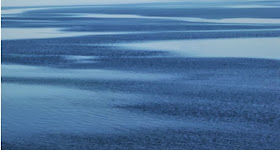By Doug
So, you've got clean air off the starting line... what's next? We'll look to see if there are clues about which side of the course is favored. This will depend on where you are sailing, and there is good news.
The top sailors tend to sail in open water where the top events are held. Most events for middle-of-the-fleet sailors are on lakes where there are lots of clues because the wind is not as steady. And the less wind you have, the more clues you'll see because the wind has less momentum and changes direction and strength more often.
In the last post, we looked how the good sailors starting at the favored end of the line can get trapped going the wrong way. But middle-of-the-fleet sailors who get clean air are more likely to be able to tack when they want. Consider a pin-favored start but where there is better wind in the middle or on the right.
In the last post, we looked how the good sailors starting at the favored end of the line can get trapped going the wrong way. But middle-of-the-fleet sailors who get clean air are more likely to be able to tack when they want. Consider a pin-favored start but where there is better wind in the middle or on the right.
 |
| Pin favored, but wind on the right... many good sailors will miss this. |
In these conditions, the golden rule is to stay in the pressure where there is more wind. I'd rather be conservative, go for clean air, and then head for the pressure knowing that sailing in pressure in light air is more important than on being a lift. It's pretty simple: dark patches = more wind = more speed. For me in these conditions, wind strength is more important than wind direction or line bias.
Here's a more interesting example where the patterns show exactly where the pressure is. If it's pin favored, this wind pattern might be wasted because very few in that group will be able to tack.
I'd much rather start where I'm able to tack. Here's why. Look at the wind as an obstacle course - where do I need to go to avoid the dead patches and stay in the wind?
Planning the route is simply connecting the dots, and the first dot is off to the right so I'll need to tack ASAP.
In this extreme example, four tacks keeps me continuously in the pressure. I'd much rather have the chance to do this at the committee boat end of the line than risk being trapped going the wrong way at the more favored pin end of the line. Only clean air and a more conservative start will give you the chance to do this. Advantage to middle-of-the-fleet sailors!




Great advice. But aren't those photos taken from much higher than a Laser cockpit?
ReplyDeleteAlso, what do you have to do different in looking the pressure on a run?
The first picture was taken standing on a dock, so it's the same as standing on a Laser. The others were taken from the Web.
ReplyDeleteI'm going through the race chronologically and will talk about going downwind, but for now, staying the pressure is easier on a run because going with the wind you have more time to pick and choose where to go.
Great explanation. Great photos. This is one of those things that make sailing so much fun. Keelers are often seen standing on the boom to get a better view. U just need to remember, that the red dots are moving towards you at wind-speed. Seeing a pattern like this - say two minutes before start - it might be totally different at gun-time. Downwind? Easy! Look back to see pressure.
ReplyDeleteThanks for your comments. It's a great idea to stand up before the start to get a better view.
DeleteOn rare occasions the wind patterns do not move towards you. This happened at last year's Masters Midwinters East where I wrote "I’ve learned the hard way that a slight breeze that's moving towards you is better than a stronger breeze that's stationary." Thankfully this does not happen often.
http://www.laser.org/index.php?option=com_content&view=article&id=966:2012-florida-masters-midwinters&catid=19:masters&Itemid=266
http://www.impropercourse.com/2012/02/2012-florida-masters-midwinters-east.html
Right but those occasions are rare - at least on open water. On lakes it's a different story. Inshore racing may also have local "hotspots" with stronger winds - and idle waters. I usually race in coastal waters; We get both. When the wind comes fro the sea it is perfectly regular. When it comes from land there's all sorts of irregularities...
DeleteThis comment has been removed by the author.
ReplyDelete